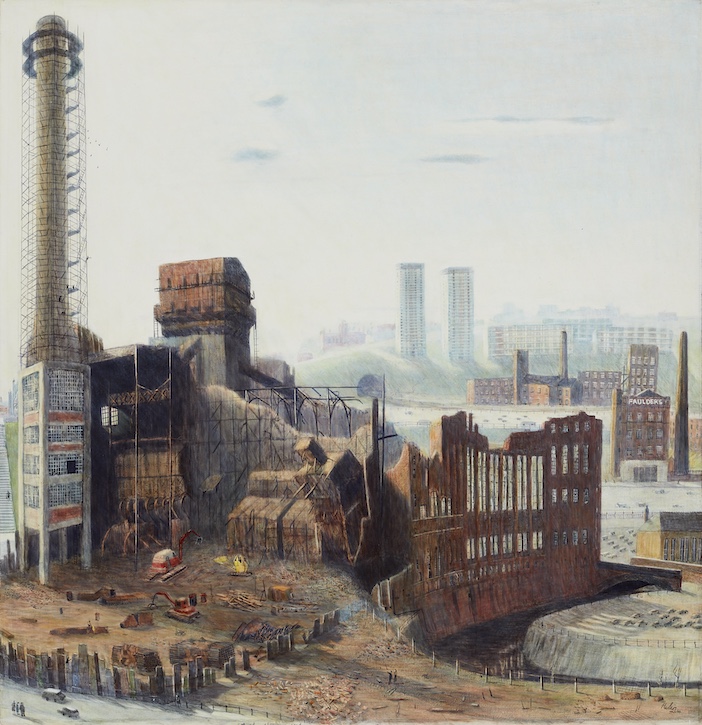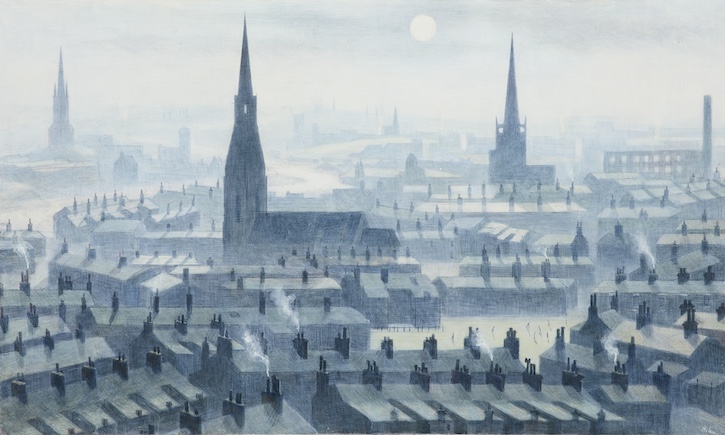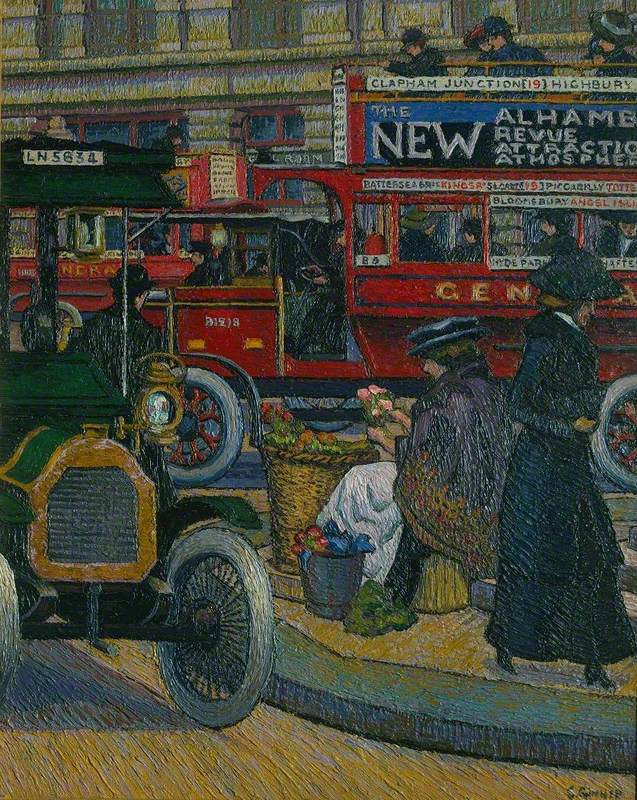Helen Clapcott (b.1952) has been painting the town of Stockport, near Manchester, for more than 50 years. She grew up in Stockport from the age of 10, studying at Liverpool College of Art and then the Royal Academy Schools in London. After a few years 'down south', in 1984 she came back to her roots and Stockport has been her primary subject ever since.
Helen Clapcott in her attic studio, May 2020
She has exhibited widely in the north of England and in London and the home counties, and her work can currently be seen in a large retrospective exhibition at Stockport War Memorial Art Gallery (until 25th January 2025). She paints exclusively in egg tempera, but also makes watercolour notes and drawings in pencil and oil paint on paper. Her chief subject is how the old mill buildings, temples of Victorian industry, have been pulled down and replaced by motorways and carparks.
The Last of Stockport Paper Mill
2002, egg tempera on gesso panel by Helen Clapcott (b.1952) 
Andrew Lambirth: How do you decide what you're going to paint?
Helen Clapcott: I don't decide, the landscape tells me what to paint. I'm reacting or responding to something I've seen – demolition, the motorway, the carnival – captivating subjects, fantastic sights, forever surprising.
The Last Carnival
2018, egg tempera on gesso panel by Helen Clapcott (b.1952) 
Andrew: Tell us more about how you work in the studio. Do you work on an easel? How do you approach a new work?
Helen: Standing for prolonged periods would be far too energetic and it's not practical for close work on a small scale. I slouch at an old desk resting on my left arm.
I don't draw an image out first, I just let the painting evolve as it's crafted, altered and changed. I begin by choosing the gesso panel I feel is the right size and the colours for the kind of light I have in mind. I feel my way into the narrative with soft washes and lines, followed by a lot of alterations and rubbings out, especially in the first days of a painting. As the painting progresses the process of rubbing out and repainting continues. No wonder I take so long to finish a painting!
Andrew: So, you might rub things out the same day you painted them. Do you always do that?
Helen: Often, yes! I can get carried away when I'm rubbing out and be left with an empty panel… 2 am is not a good time to pick up a rubber. It's useful to have the painting visible when I wake in the morning and to see it in a fresh light. Shifting the viaduct four millimetres to the left is preferable to having nothing to work from.
Andrew: Do you mix your own paint?
The Power Station
1984, egg tempera on gesso panel by Helen Clapcott (b.1952) 
Helen: Yes, out of pigment and egg yolk. Fresh eggs every day, I mix a blob of yolk with the same amount of powder pigment and dilute with water. I have eight favourite colours – a cold and warm red, blue and yellow: Cadmium Red Deep, Alizarin Crimson; Ultramarine Blue, Prussian Blue; Cadmium Yellow, Lemon Yellow, plus white and an earth colour – Burnt Sienna or Venetian Red. Mix Venetian Red with Prussian Blue and you get a really deep vibrant colour. Prussian Blue is lovely to mix, it seems to melt as you add the yolk. Burnt Sienna and Ultramarine Blue make a wonderful black.
Andrew: What appeals to you particularly about using egg tempera?
Helen: Watercolour turns muddy if it's overworked and the paper surface spoils if it's not fully dry between washes. I make countless changes as I'm evolving a painting. Tempera dries quickly, there's no waiting; one can build up colour with lots of glazes and the gesso surface is more resilient than paper; it allows one to erase an area of paint, without damaging the surface of the board so the white behind the colours keeps them looking fresh.
I discovered tempera at the end of my second year at Liverpool. A year and a half later, when I arrived at the Royal Academy, I was thoroughly enjoying painting in tempera and running with it.
Back Garden in Winter
1981, egg tempera on gesso panel by Helen Clapcott (b.1952) 
Andrew: Let's talk about some specific paintings. You were still a student at the Royal Academy (1975–1958) when you painted The Life Room, RA Schools, weren't you?
Helen: I loved being at the Royal Academy. While art schools throughout the country were discarding the past in favour of new styles and fads, the Academy kept and valued its drawing traditions. Its history was visible in the corridors lined with plaster casts and in the Life Room with its circle of benches facing the stage where the life model would pose. The model never interested me – someone sitting/lying still for hours in poses that didn't reflect their personality. The activity in the Life Room however was entertaining. Those students who turned up, the regulars, always chose to sit in the same spot on the benches; I painted the room with its inhabitants.
Andrew: You put yourself into this painting, didn't you?
Helen: I'm at the far right. Val, the girl in the doorway, never stopped to draw, she'd walk through, stand in that same position for a minute or two, leave and close the door. Another lass would come in, look at the noticeboard and walk out again. The crucifix on the wall and the flayed figure are those wonderful casts kept by the RA.
Andrew: That's a peculiar pose you've got the model in.
Helen: It was a rest position the model chose after standing for an hour, she put her legs up to rest them, a more natural position than those instructed by a student – 'Can you put a twist in it to make it more interesting?' I demanded we kept it as a long pose.
Andrew: Were you more interested in painting than drawing at the Academy?
Helen: I wasn't familiar enough with the subject to have fun with drawing and I needed the subject in front of me. It was nearer copying than painting. I painted what was there – almost photographic (without photographic perspective) – but a true record of the Life Room.
Andrew: Here's a very different painting, a landscape called Hayle, St Ives – was it made earlier than the Life Room?
Helen: About the same time. It would have been done on a week's holiday, and I would have taken my paints down to the beach. I took paints wherever I went. As L. S. Lowry said, it's a good way of passing the time. It was summer, I shared a holiday house for a week with a group of students, ate fish and chips, drank in the evenings and painted in the day. That picture would probably have been painted in two afternoons. It's quite small and I was quick. Painting on the spot is much quicker than painting in the studio which can become a nightmare of changes and alterations!
Andrew: One of the things that makes that picture work is the train on the hillside opposite.
Helen: I remember thinking 'What on earth is the train doing almost next to the sand? Surely it will get washed away!'
Andrew: The third painting of yours on Art UK is Travis Street. Tell me about this Stockport painting.
Helen: It features the chimney I loved. It's scaffolded because they were taking it down. The flue to the chimney went under the mound on which it stands and across the road to a demolished mill. I've painted that chimney (by Travis Street) over and over again and it's still the subject of many subsequent paintings despite having disappeared more than 50 years ago.
Andrew: There's another piece of demolition in the middle of the painting, where the cranes are. What's that?
Helen: That'll be one of the mills. Everything got pulled down to make way for the motorway.
Brinksway, 1979. Before the Motorway
1979, egg tempera on gesso panel by Helen Clapcott (b.1952) 
Andrew: Did you feel you were recording history in the making with the destruction of the mills?
Helen: No, I thought I was just recording what was going on at the time. But I didn't even think of it as recording, I just saw it as a phenomenal sight. The recording happened by accident. It was my favourite bit of Stockport; I visited the area again and again. And it's all gone, a whole community. There's still a lady who walks a dog down near the river, who lived there.
Motorway Route
2014, oil and pencil on paper by Helen Clapcott (b.1952) 
Andrew: Can you name your three favourite paintings in your exhibition?
Helen: No, but here are five I really like. The Last of Stockport Paper Mill (2002), The Power Station (1984), The Churches (2014), The Last Carnival (2018), and Brinksway, 1979. Before the motorway.
The Churches
2014, egg tempera on gesso panel by Helen Clapcott (b.1952) 
Drawing and watching cold mist shroud the mills; church spires on the skyline; the carnival – marching up the A6, and demolition: diggers dancing down their selected prey. Compelling moments I remember vividly, my favourite times, which is perhaps why they are my favourite paintings.
View from Wellesley House down the A6
2010, watercolour drawing by Helen Clapcott (b.1952) 
Andrew: Now that you've got this big exhibition, looking back over your career, has it revealed to you anything about your work?
Helen: Yes – and I'm going to sound right big-headed – I think the show looks beautiful, I'm very pleased with it. Something of the joy I have for the landscape and life of the town – the fantastic sights I've delighted in – is present in the paintings and remains alive. So, I suppose I've gained a bit of confidence, and learnt that the paintings I was doing at the time that I hid in the shadows and that received so much criticism, are of merit.
Andrew Lambirth, writer, critic and curator
Andrew's book, Helen Clapcott: In the Light of Buildings, is published by Lund Humphries. 'Helen Clapcott: A Portrait of Stockport' is at the Stockport War Memorial Art Gallery until 25th January 2025
For more information, visit helenclapcott.com
This content was supported by Jerwood Foundation






















